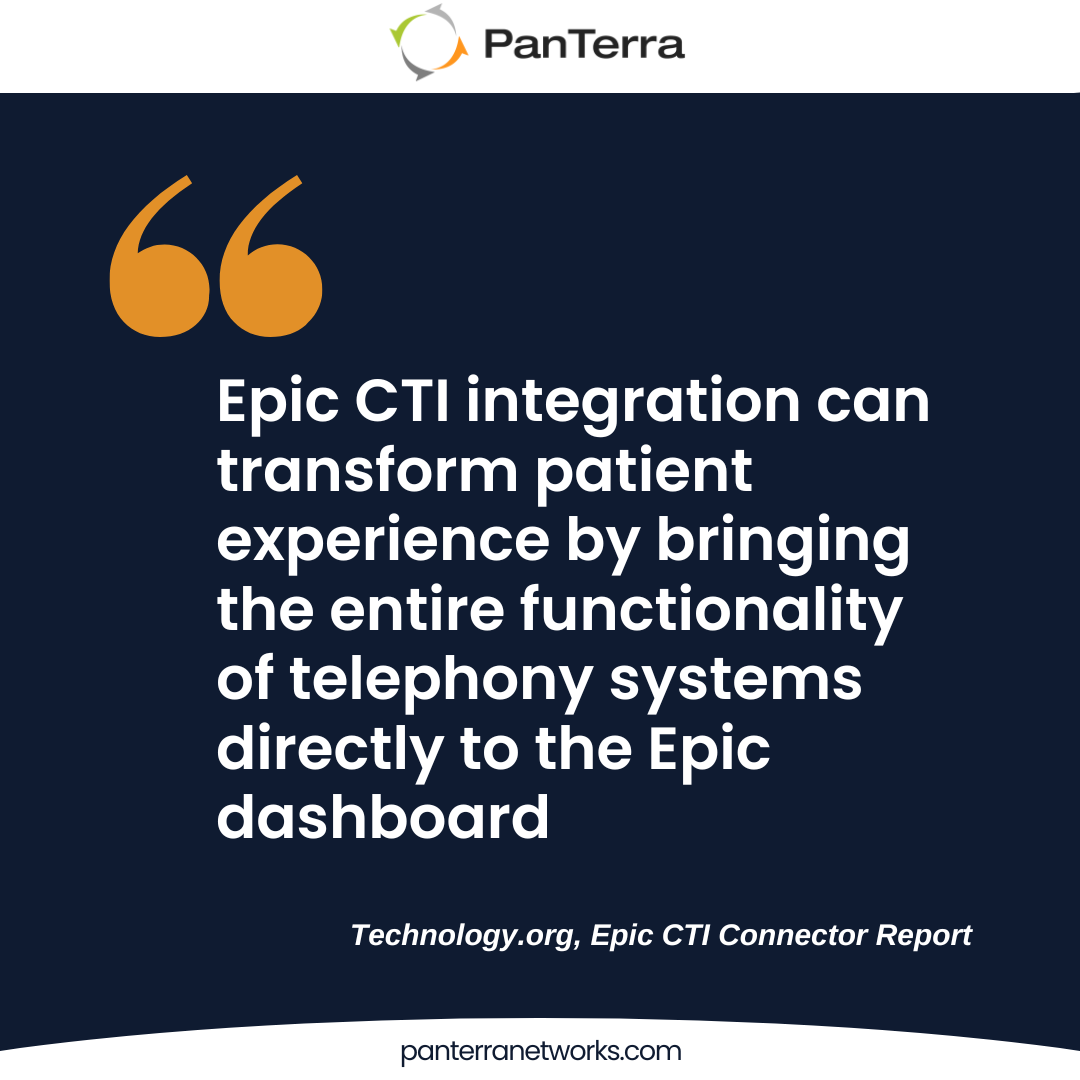Meet the Epic Integration Your Patients Have Been Waiting For
October 29, 2025

In healthcare IT conversations across the industry, one requirement keeps resurfacing: Epic integration.
A 400-person healthcare organization summarized their needs clearly: “HIPAA-compliant VoIP with digital assistant workflows and scheduling queues.” But their non-negotiable? It had to work with Epic.
Years of working with the industry made one thing clear: the tools that help are the ones built around real clinical workflows, not the other way around.
That’s exactly what PanTerra recognized early on—healthcare teams need a communication platform that speaks Epic’s language natively, without disrupting care delivery.
Why Epic Users Are Still Taking Notes on Paper
The Daily Reality of Epic Without CTI
The frustration shows up clearly in user discussions. Without Epic CTI integration, every patient call starts the same way: an agent sees a phone number, nothing else.
They answer blind, ask for the patient's name, then start the hunt through Epic while making small talk.
Healthcare workers describe the reality:
"Agents toggle between Epic and our phone system all day. Screen pops only show caller ID, no patient context, no history, no reason for calling." Some facilities report agents keeping notepads specifically to jot down patient names while navigating between systems.
This manual back-and-forth wastes time and invites errors.
- Agents pull wrong charts.
- Previous interaction notes get missed.
- Patients calling back reach new agents who lack context from earlier calls.
The technology meant to improve healthcare delivery actually creates barriers between patients and their care teams. And the productivity loss compounds across departments.
Scheduling coordinators can't see upcoming appointments during calls. Billing teams lack visibility into recent claims. Clinical staff waste time verifying information Epic already contains.
400 People, One Clear Requirement
That 400-person healthcare organization's requirements list revealed the industry's core challenge.
They needed standard features: IVR, call queues, agent management. They had existing Yealink phones they wanted to reuse. But Epic integration stood out as the make-or-break requirement.
The discussion exposed a market gap. Traditional UC vendors suggested adding Epic "later" through third-party tools. Healthcare-focused vendors had Epic connectors but lacked robust telephony features.
They faced a choice no healthcare provider should have to make: strong telephony or real Epic integration.
What's particularly revealing is their concern about vendor stability. They'd watched peers suffer through botched implementations where providers made "production-level changes without telling us."
One facility lost phones for half a day when their vendor pushed untested updates. In healthcare, where communication directly impacts patient care, that kind of uncertainty simply can't happen.
Production Changes That Break Patient Care
The vendor stories in these discussions show why healthcare teams approach new systems with caution. Several facilities described phone providers treating them like any other business, pushing updates during business hours with no warning.
"Their technical teams made production changes to our system without notification," one user wrote about a major UC provider.
“Our most productive facilities went silent for hours during peak schedules.” The vendor’s response was routine troubleshooting, as if patient communication could wait for a maintenance window.
Another medical office discovered the limits of its platform only after rollout. Despite promises of EMR integration for “easy chart lookup when patients call,” the result was manual searches and frustrated callers. The vendor dismissed it as a “roadmap item” for a future release.
These incidents aren’t rare. Healthcare organizations repeatedly describe the same pattern. A system can perform flawlessly in a demo and still collapse under the pace of a real clinic.
Hear it from expert Roni Jamesmeyer at our latest webinar:
[video]
Decoding Epic's Communication Modules
Why Other Vendors' Epic "Integration" Falls Short
Some offer basic connectors that only pull patient names. Others break when healthcare systems upgrade their EMR. Most treat it as an afterthought, a checkbox for RFPs rather than core functionality.
Real integration means instant access to complete patient context during calls, not just demographic lookups.
It means supporting all EMR environments as they evolve, not forcing teams to choose between staying current or keeping phones working.
This gap became clear when the three largest healthcare providers in the U.S. evaluated phone systems. They needed native CTI that scales with their operations, not another integration project to manage.
At PanTerra, we built our healthcare communication platform differently, with EMR connectivity at its foundation, not bolted on through third-party tools.
4 Ways Epic CTI Transforms Patient Experience
As one industry analysis put it, “Epic CTI integration can transform patient experience by bringing the entire functionality of telephony systems directly to the Epic dashboard.”
That line captures the heart of what real integration delivers: faster, more personal, and more reliable communication that strengthens trust at every touchpoint.
In practice, Epic CTI changes how healthcare teams connect with patients in four key ways that directly improve satisfaction and trust.
-
Context arrives before the call begins.
When patients reach out, agents see the full picture instantly: recent appointments, pending labs, and care team notes. The information-gathering phase disappears, replaced by conversations that start informed.
-
Questions get resolved on the first call.
With complete patient context in view, agents can confirm details, answer billing or scheduling questions, and close requests without switching screens. What once took minutes now takes seconds.
-
Empathy scales with visibility.
When technology removes friction, people connect more easily. Agents know if this is the patient’s fifth call this week or if they’ve recently received a new diagnosis. That awareness shapes tone, pace, and understanding—small details that rebuild trust.
-
Every interaction feels personal.
Epic CTI lets agents greet patients by name, reference recent visits, and route calls based on care relationships. It’s the difference between being treated like a file number and feeling known by your healthcare team.
Migration Without Disruption
Transitioning from legacy systems—especially Avaya, which dominated healthcare for years—to Epic-integrated communications doesn’t have to disrupt operations.
The organizations that succeed take a phased, disciplined approach that keeps patient communication steady throughout the process.
They begin with pilot teams handling high call volumes but limited complexity, scheduling or billing departments, for instance. These groups validate the integration, surface technical issues early, and build internal advocates before broader rollout.
The migration itself should feel invisible to patients. Platforms like PanTerra run alongside existing infrastructure, allowing departments to move when ready, not by rigid schedule.
Numbers port smoothly, workflows stay connected to Epic, and care teams keep communicating without interruption while the foundation quietly upgrades beneath them.
This transition mirrors what we’ve seen in AI-driven communication success stories, like how healthcare saves $40K daily with AI patient communication solutions.

Your Epic CTI Implementation Guide
Does it support all Epic environments as they evolve?
Many vendors work with older modules, but break when Epic updates. True integration (like with Streams.AI) stays compatible as the platform evolves.
What does the agent actually see during a call?
A name and number aren’t enough. Agents should instantly view demographics, recent encounters, care team details, and interaction history. Always test with your own workflows, not a canned demo.
How does it behave when Epic goes offline?
Maintenance windows happen. Real integration maintains call flow and routing even if Epic is down, then syncs data automatically once it’s back online.
Can departments customize their workflows?
An emergency nurse and a billing coordinator need different information on-screen. Your CTI should adapt to each department’s role, not force everyone into the same template.
The 90-Day Deployment Reality
Healthcare organizations often underestimate what it takes to deploy Epic CTI successfully.
Based on real implementations, the first month typically focuses on the technical foundation: establishing Epic connectivity, configuring security protocols, and validating data mappings.
Testing begins with synthetic data, allowing teams to verify reliability and compliance without risking live records.
As deployment moves into its second phase, attention shifts to workflows. Department leaders identify how Epic CTI should fit their day-to-day processes:
- schedulers need visibility into appointments,
- clinical teams depend on visit summaries,
- billing staff require claim context.
Each workflow is refined and tested with real users to ensure the integration aligns with how healthcare teams actually operate.
By the final stretch, the focus turns to live readiness and stability. Pilot groups begin using the system in production, supported by close monitoring, quick troubleshooting, and staff feedback.
The goal is for patients to notice only smoother communication, not a transition. When Epic workflows continue uninterrupted and teams handle calls more confidently, that’s when integration has truly succeeded.
Building Patient Trust Through Epic Integration
When Epic and the communication system work as one, the results are immediate.
Agents stop switching screens. Clinicians get the full picture before they speak. Patients notice shorter calls and fewer repeated questions.
For healthcare teams, that consistency is what builds trust over time. Every call connects smoothly, every record appears when needed, and every handoff feels natural.
It’s the kind of reliability that turns a complex system into part of the background—steady, predictable, and built for care.
PanTerra’s Epic integration was designed with one goal from the start: to make healthcare communication as dependable as the professionals who deliver it—and to give organizations a trusted alternative as legacy vendors like Avaya exit the market.
.jpg?width=500&height=500&name=Are%20you%20Getting%20a%20Good%20Deal%20(1).jpg)
Comments